- Home
- Howard, Bob
The Infected Dead (Book 4): Exist For Now Page 9
The Infected Dead (Book 4): Exist For Now Read online
Page 9
“Give me a pass the same way on the right side, Chief. I’m getting some good video on my cell phone.”
The Chief brought the plane around and lined it up with the opposite side of Ambassadors Island. This time he was able to hug the shoreline even better because it was a straight run, and the homes seemed to streak by beneath him. He didn’t see any movement, and that was more of an indication that there were living people on the island than infected dead. If there were infected, they would be drawn into the open by the sound of his engine. Living people would be hiding.
When the plane reached the bridge for a second time, the Chief banked the plane away from the island and set a course back toward the southeast. He pointed in that direction and told Kathy it looked like the deepest water without a shoreline too close to them would be back toward Charlotte. He told her he was going to stay as far out over the water as possible and then turn northeast to where I-77 crosses part of the lake. He said it would be good to know if the road was passable to the north, but as with many bridges, they were more often death traps.
When they reached their turning point, the Chief made note of three islands on the right and two on the left. It would be so tempting to put a shelter on any of them for the short term, but even without a shelter there had been many people who saw them as the only safe place to be. They didn’t have visible shorelines, which meant good fishing from the steep banks under the trees, and deep water that would prevent the infected dead from just strolling into a camp. Two of the islands had small boats tied at spots that had been used by campers over the years, but there were no people moving around, either living or dead.
The Chief pointed to a deep water turn up ahead and said, “That looks like Davidson Creek. About two hundred yards from there we should be able to land and still be able to see the bridge on I-77. It’s far enough from land for us to get a good look at the video you did.”
As he approached the spot, the Chief came in lower but stayed high enough for them to be able to see the bridge at the same time. Just as he expected, the bridge was jammed with infected dead, and even though they were still far from the bridge, the infected were drawn to the sound of their engine. Before the Chief could sit the plane down on the water and cut off the engine, the infected were falling over the railing into the water.
Even though this particular bridge looked like it had land under its entire length, it was still high enough above the water to allow for the usual spectacular show from the uncoordinated infected dead. It was always a sight that made Kathy think of cliff divers who didn’t know how to dive. There was no attempt to enter the water feet first or by extending the arms toward the water for a smooth entry. Some were sideways, some were spinning out of control, and some were doing cartwheels, but none of them knew they were falling. It was probably best described as tumbling into the water.
“What do you suppose happened on that bridge?” she asked the Chief.
“The only thing I can guess is that someone tried to cross it and got cut off before they made it,” he answered. “Let me get a look at that video.”
Kathy handed him the phone then started scanning the shoreline on all sides for movement. She thought it was a bit odd, but there was no activity until they had reached Davidson Creek. Then there was movement on both sides of the lake as far as she could see. The Chief had to be right. Something big had happened that had drawn the infected into the open and toward this part of the lake.
On the shoreline nearest to them on the right, Kathy focused her binoculars on one large group of infected dead that were moving toward a circle of homes at the end of a street. They didn’t appear to be interested in the homes but were walking in the general direction of the plane. She thought to herself that they must have been drawn to the sound of the plane’s engine, but when it cut off, they just kept walking.
The street sign Kathy could see behind the group of infected dead said they were shambling down John Gamble Road, and Kathy wondered what it had looked like before. There were only about a dozen homes on the street, and it looked like it would have been a great place to live. She absently wondered if the dead she saw walking down the street had been the people living in the homes, or if they were invaders who had killed the residents of the peaceful street.
“So much has changed,” she thought out loud.
The Chief pushed the video over in front of Kathy and snapped her out of her private thoughts. He had paused it on a spot along the right side of Ambassadors Island where there was a thick growth of trees and no house.
“There are about three dozen houses on the island. Every lakeside piece of property has a house on it except this one. I think it might be door number one.”
He moved the video forward a few frames until he reached a house only nine lots further up the island on the right side.
“See anything different about this house?” he asked.
Kathy compared it to the other houses and quickly spotted the difference.
“It’s the only house without a private dock,” she said. “To live in this neighborhood, you’d better be able to keep up with the Joneses. That means if thirty-five people have private docks and boats, number thirty-six would have one, too. Any chance they haven’t gotten around to building it yet?”
“Not a clue,” said the Chief, “ but where the dock meets the water would be a good place for door number two.”
“You think this one has a third door like the others?”
He nodded and ran the video back to the beginning of their pass over the island. He stopped it right as the plane had passed over the barricaded bridge and gates and pointed at the round-about that looked like part of the landscaping at the main entrance. Kathy didn’t see it at first, but then she realized what she was looking at. The round-about wasn’t paved. It was made of red brick, and from above it looked like the points of a compass, including the midpoints. The points were even aligned with true north.
Kathy looked at the Chief hoping he had a clue which point of the compass was aimed at the door, and he was grinning. She couldn’t stop herself from grinning with him, but she still didn’t know what he was waiting to tell her.
“Well, are you going to tell me, or do I have to guess?” she asked.
The Chief asked, “Have you ever compared a compass to a combination lock, or the lock on a safe? Combination locks are great for gym lockers, but they have less numbers. Northwest on a combination lock has the number thirty-five, while northwest on a bank vault dial has the number ninety.”
“Don’t tell me,” said Kathy. “The combination for this shelter door wouldn’t happen to begin with ninety, would it?”
The Chief gave her a broad smile.
“That’s my girl,” he said.
CHAPTER FIVE
Suburban Life or Death
Hampton had slept with one eye open because the groaning went on all night. The sun was slowly beginning to come through the skylights, and Colleen was still stretched out across the sitting area a few feet away. She had a pillow under her head and a blanket up to her shoulders, but she had chosen the carpeted floor over the beds. There was just something about being caught in a bed. Beds didn’t feel safe anymore, and it wasn’t because something was hiding under them. It felt like you should be hiding under the bed instead of sleeping in it.
He wasn’t sure if he could sneak past Colleen, but he had to use a bathroom and then try to find some food. Somewhere in the craziness on I-77 he had forgotten about getting away with supplies.
Colleen didn’t move, and her breathing was even. She was more exhausted than he had realized. The day before had gone well enough at first, but the movement up I-77 had begun early, and like most of the people, sleep had been elusive the night before. Everyone was either afraid or too keyed up on adrenaline to be able to rest. Once the plan was announced to the large group of survivors, there was no debate. They were running out of supplies, and it was too far to go to reach places they hadn’t already stripped b
are. When the plan started to fall apart, they were already at the edge of their limits, and the only thing keeping them moving forward was fear.
Without his boots on, Hampton was able to make it down the stairs without waking Colleen. He kept his eyes on her as his toes sank into the deep pile of the carpet, and for the second time he wondered why he hadn’t noticed her before when they were holed up in the football stadium. She really was pretty, and it occurred to him that he had never known an Irish girl as he grew up in Georgetown, South Carolina. There was probably a lot he had missed growing up in a small town, but he didn’t feel like he was ignorant about the world.
He had learned to fly an airplane and had gone to Georgetown Technical College. He played around with degrees in criminology and engineering, finally deciding on the latter because there were more job opportunities. He hunted with his friends and learned to live a peaceful life that in the end kept him alive. He remembered being told by a group of survivors who were traveling north that the infection would kill from within. Someone in the community was already hiding a family member who had been bitten.
Hampton didn’t want to believe them, but deep down inside he knew they had been right. He wasn’t the only one who made sure there was fuel in his plane and supplies stashed in the cargo section. He started carrying his rifle and a pistol everywhere he went. Not because he worried about the infected getting into Georgetown from another part of the state, but because he was worried about his friends.
He thought back to those last days with friends he had known since childhood, and he remembered how they had begun to be wary of each other. He saw the questioning looks and knew that someone was hiding a loved one. There were fewer children being seen with their parents. People who normally took their families with them everywhere when they were in town were now seen walking alone. Everyone was in a hurry, and people stopped making eye contact.
When the horde of infected dead had arrived at Georgetown on Highway 17, they felt like they were ready because of the warning they had gotten from that group of survivors. They had the high ground with two bridges, and they could shoot from the first bridge for a long time before retreating to the second bridge. They would be cutting off one of their own major arteries out of the city, but as soon as they saw what was coming toward them, they knew they had no choice.
The plan worked as well as they could have hoped, and for the short term they were safe. They began shooting with hunting rifles as the leading edge of the horde approached the bridge. The rows of bodies slowed the approach of what appeared to be thousands of the infected dead, and as the piles of bodies grew, the horde spread to the left and the right sides of the highway. The sheer pressure of that many infected dead caused those in front to be pushed forward as if there was a bulldozer behind them.
Since the trees lined the highway almost all the way to the first bridge, hundreds of the infected on the fringes of the horde were crushed against the trees. They were pinned in place and continued to wave their arms and snap their teeth in the direction of the living who were shooting down at them. Hampton kept yelling at the men not to shoot at the infected that were in the trees and to focus on the ones on the highway. As long as the trees were getting jammed up, the infected would continue to be forced to the outside.
Just as he expected and hoped for, the infected dead that were forced to the outside gradually began appearing around the trees. They pushed each other forward and began stepping off into the soft mudflats that lined the banks of the Waccamaw River. For as far as the eye could see, the brown mud waited to trap anything that dared to walk onto it, and Hampton was convinced they could steer the horde that way.
As he and his friends watched, the infected stumbled out onto the mud and began to get stuck. When they couldn’t move forward, they began to be pushed down into the mud by the infected dead that were crawling onto their backs. It wasn’t long before there was a solid bridge of struggling infected dead all the way to the river, and the dead that managed to crawl over them were pulled away by the swiftly moving water. They were beyond the beginning of the bridge and were no longer a threat.
Almost thirty minutes after the shooting started, there was still no end in sight. The infected dead were still pushing from behind in unbelievable numbers, and Hampton yelled for everyone to stop firing. An ammunition check was done, and they didn’t need a math genius with a calculator to tell them they were going to run out of ammunition long before they ran out of infected dead to shoot.
Hampton and his friends got together for a quick discussion about what they should do, and it was obvious to all of them. The horde couldn’t be stopped by bullets, but maybe they could be stopped by the river. It was time to drop the first bridge. The charges were in place, so all they had to do was to pull back and wait for the parade to come to them. They gathered their gear and loaded into waiting pick up trucks. From high ground they could see that a sizable force of the infected had already pushed through the bodies at the base of the bridge and begun the upward climb. They were spread out, but they were coming.
The small army of people trying to stop the infected dead from reaching Georgetown drove from the bridge over the Waccamaw River until they reached the second span. It passed over a narrow strip of land that separated the Waccamaw River from the Great Pee Dee River and was worth saving if it could be done. The bridge over the Great Pee Dee River might be useful if they survived long enough. From there they waited until the horde of infected dead reached the crest of the bridge over the Waccamaw River. Then they began detonating the charges.
The first blast took out a large portion of the bridge and hundreds of the infected dead with it, but something caused the charges to fail along one entire side. Of the four lanes crossing the bridge, two lanes remained intact from one side of the river to the other. The bridge had split right down the middle, and the infected were still falling over the edge, but they still had two lanes to use. Hampton and his friends couldn’t believe their eyes as thousands of the infected continued their march toward Georgetown.
For a second time Hampton called everyone together to talk about their next move, and it was an easy decision. They were going to put all of their cards on the table by dropping the second bridge before the horde would have a chance to reach it. If the bridge didn’t fall as planned, they would at least have the time they needed to start an evacuation of the city.
Hampton gave the signal to move back, and once again they retreated from the advancing wall of death. This would be their last chance to stop the horde from reaching them, so it had to work better than before. They didn’t wait on the bridge to watch. Instead, they drove to the bottom of the bridge and gave the word to the anxious spectators near the city marina to get ready to evacuate if the bridge didn’t fall.
Once everyone was in position, the signal was given, and the second set of charges was detonated. There was first a collective sigh of relief, and then a cheer went up from the crowd as the entire bridge over the Great Pee Dee River fell. The only thing left standing was the center span where it crossed the narrow strip of land separating the two rivers.
Hampton sat down to watch as the infected dead continued their march. Once they reached the end of the center span, they just walked right over the edge. There was a pile starting to form at the bottom of the bridge, but anything that managed to crawl off of the pile found itself either going in the wrong direction or walking straight into the swift current of the Great Pee Dee River.
The memories from that day had played over and over again so many times in his mind. They had stayed alive against so many of the infected dead, but they couldn’t survive the days that followed. They could fight together against an enemy that they could see, but they couldn’t fight against the unseen enemy that was already within their city streets. It began only three days later when there were several incidents at the same time. More than one family had an infected relative or loved one they were hiding, and once it began to spread there was no way t
o stop it. There was no bridge to drop this time.
Hampton was inspecting his plane when it started. He had gotten in the habit of doing preflight checks two or three times a day before the battle at the bridges, so it wasn’t unusual for him to be there again. He had even spent a few nights sleeping in his plane, just as he had done after the battle.
A police car with its blue lights on raced past the fence surrounding the small city airport. Hampton watched it turn the corner a few blocks away and then reached into the cockpit to turn on his radio. He knew what was happening almost immediately. The police dispatcher was asking for everyone available to respond because an officer was down. She said something about a domestic dispute and that deadly force was authorized. He couldn’t remember that call ever being made by dispatch.
The next calls from dispatch said it had happened again over by a hardware store near the airport, and that the ambulance driver who responded was being attacked. Hampton could see the hardware store from where his plane was parked, and the ambulance driver was nowhere in sight. What he could see was an infected dead pulling an elderly woman to the ground. Her screams carried to Hampton as the dispatcher went silent. There was only static coming from the radio.
He remembered thinking that they had been warned, but after they were warned, there wasn’t anything else they could do. They had to at least try to keep their city together. They had defended it, and then came a time when it would be up to each person to stay alive. He had climbed into his plane with no real thought about where he should go. Once he was in the air, he decided the mountains might be safer than the coast, so he pointed the plane in that direction. Hampton didn’t look back because he was pretty sure of what he would see. No one else was taking off from the airport, and it wasn’t likely that anyone else would.
Hampton had almost forgotten why he was in the kitchen of the big house. Then he remembered Colleen upstairs on the floor, and he went back to his search for food. He wondered how long it would be before he quit getting lost in his thoughts about those days when Georgetown fell to the infected dead.

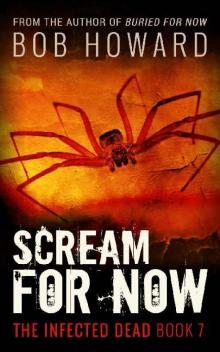 The Infected Dead (Book 7): Scream For Now
The Infected Dead (Book 7): Scream For Now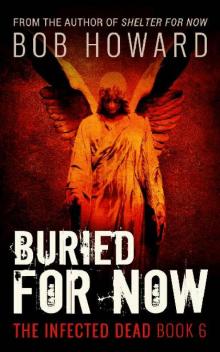 The Infected Dead (Book 6): Buried For Now
The Infected Dead (Book 6): Buried For Now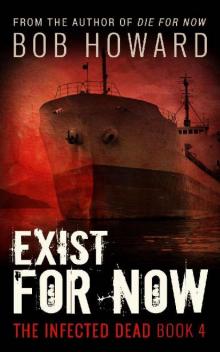 The Infected Dead (Book 4): Exist For Now
The Infected Dead (Book 4): Exist For Now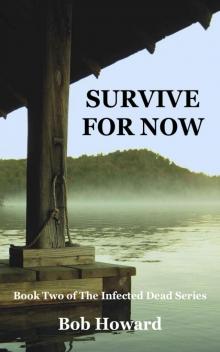 The Infected Dead (Book 2): Survive For Now
The Infected Dead (Book 2): Survive For Now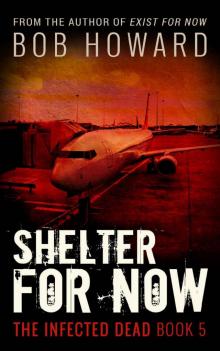 The Infected Dead (Book 5): Shelter for Now
The Infected Dead (Book 5): Shelter for Now